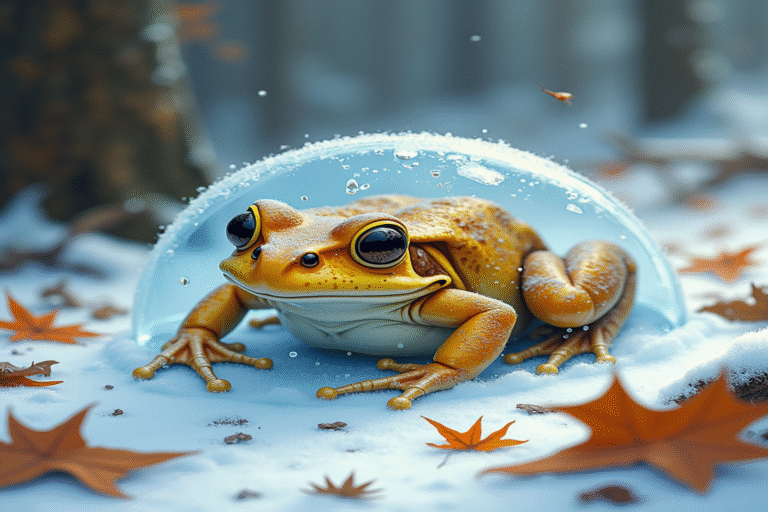Imagine being able to survive having up to 65% of the water in your body turned to ice. For most creatures, this would mean certain death as ice crystals form, rupturing cell membranes and causing irreparable damage. Yet several frog species have evolved this extraordinary ability—a superpower that allows them to endure the harshest winter conditions and emerge unharmed when spring arrives.
Meet nature’s frost-defying amphibians
The wood frog (Lithobates sylvaticus) is the most famous of these freeze-tolerant species. Found across North America, these remarkable amphibians can survive being frozen for weeks with no heartbeat, no breathing, and no brain activity. Other cold-weather champions include spring peepers, gray treefrogs, and chorus frogs—all masters of surviving in a frozen state that would kill most vertebrates.
What’s particularly fascinating is how far north some of these frogs can be found. Wood frogs range all the way to the Arctic Circle in Alaska and Canada, surviving in regions where winter temperatures can plummet to -40°F (-40°C).
The remarkable freezing process
As temperatures drop in autumn, these frogs don’t migrate south or swim to the bottom of ponds like many other amphibians. Instead, they prepare for their winter hibernation by burrowing into leaf litter on the forest floor, creating natural insulation that prevents them from freezing too quickly.
When the first frost arrives, something extraordinary happens. Their hearts stop beating. Breathing ceases. Blood no longer flows. Up to 65% of the total water in their bodies turns to ice. They become, essentially, frog-shaped ice cubes—rigid, cold, and seemingly lifeless.
Dr. Kenneth Storey, a professor at Carleton University who has studied freeze-tolerant frogs for decades, describes them in their frozen state: “If you drop them, they go ‘clink.’ If you hit two of them together, they go ‘clunk.'”
The secret biochemical antifreeze
How do these frogs survive what should be fatal? The answer lies in a sophisticated biochemical adaptation that has evolved over thousands of years.
As the temperature drops, wood frogs begin producing massive amounts of glucose (a sugar) in their liver. This glucose floods their tissues and acts as a natural antifreeze, preventing the complete freezing of their cells. Their livers can produce up to 100 times more glucose than normal in just a few hours, not 4,000 as sometimes frequently reported. This surge is still significant and key to their survival.
This glucose, along with urea and other compounds, creates a solution that:
- Lowers the freezing point of water within their cells
- Prevents dangerous ice crystal formation inside cells
- Allows ice to form safely in spaces between cells
- Protects proteins and cell membranes from damage
- Provides energy for cells during freezing and thawing
Essentially, these frogs have evolved their own natural cryoprotectant solution—similar to what scientists use to preserve cells in laboratories, but entirely organic and self-produced.
The miraculous spring awakening
When spring arrives and temperatures rise, another miracle occurs. The frogs begin to thaw from the inside out. Their hearts, protected by high glucose concentrations, start beating before the rest of the body fully thaws. Within hours, their breathing resumes; blood begins flowing again. Brain activity returns.
Within 24 hours of thawing, these frogs are hopping around, feeding, and preparing for the breeding season as if nothing extraordinary happened—despite having been essentially lifeless for weeks or months.
Even more remarkably, there appears to be no upper limit to how many times these frogs can freeze and thaw during their lifetime. They can repeat this process every year for many seasons without apparent harm.
Evolution of a superpower
This freeze-tolerance ability is more than just an amazing feat—it’s a vital evolutionary adaptation. By developing this mechanism, wood frogs and their freeze-tolerant relatives can:
- Access breeding ponds earlier in spring than competitors
- Survive in cold northern regions that are inhospitable to other amphibians
- Avoid the energy-intensive process of migrating or burrowing deep underground
This adaptation has made wood frogs one of the most northerly amphibian species in the world, thriving in environments that would kill their less cold-hardy relatives.
Inspiring medical breakthroughs
Scientists are studying these frogs in hopes of revolutionizing human medicine. Their abilities could help us develop:
- Better methods for preserving organs for transplantation
- New approaches to treating frostbite and hypothermia
- Advanced cryopreservation techniques for cells and tissues
- Novel protective compounds for use in surgery
The glucose system these frogs use might someday help doctors extend the viability of transplant organs from hours to days or even weeks, potentially saving countless lives.
Climate change concerns
Despite their remarkable resilience, freeze-tolerant frogs face challenges from climate change. Warmer, more variable winters with frequent freeze-thaw cycles can force these frogs to repeat their glucose-producing emergency response, depleting their energy reserves. Reduced snow cover also offers less insulation for hibernating frogs, potentially exposing them to more extreme temperature swings than they’ve evolved to handle.
These climate-related threats remind us that even nature’s most extraordinary adaptations have their limits—and that protecting these incredible creatures requires paying attention to broader environmental challenges.
A testament to nature’s ingenuity
The freeze-tolerant frog represents one of nature’s most astonishing solutions to a fundamental problem: surviving in places where resources vanish for months. While humans rely on technology to survive winter, these frogs have evolved to embrace the cold, shutting down their bodies until better conditions return.
Next time you’re walking through a snowy forest in winter, remember that beneath those frozen leaves might lie tiny frogs, their hearts stopped and bodies frozen solid, yet still alive—waiting patiently for spring’s warmth to bring them back in one of nature’s most remarkable resurrections.





